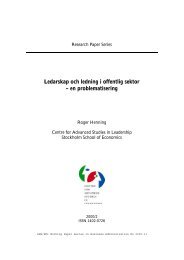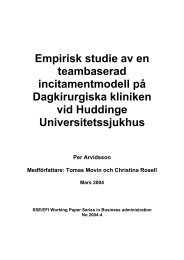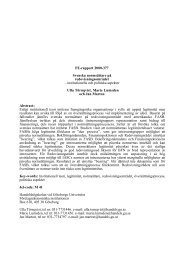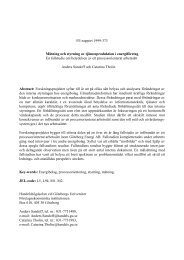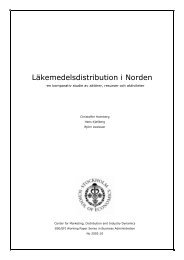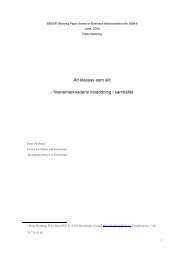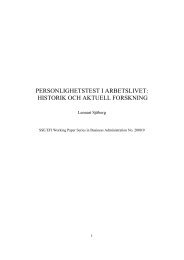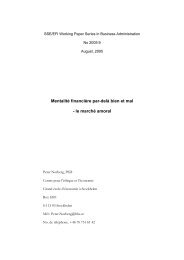Big Five Plus - S-WoBA - Handelshögskolan i Stockholm
Big Five Plus - S-WoBA - Handelshögskolan i Stockholm
Big Five Plus - S-WoBA - Handelshögskolan i Stockholm
Create successful ePaper yourself
Turn your PDF publications into a flip-book with our unique Google optimized e-Paper software.
159. Matthews, G., Deary, I. J., & Whiteman, M. C. (2003). Personality traits, 2nd ed. Cambridge:<br />
Cambridge University Press.<br />
160. Matthews, G., & Stanton, N. (1994). Item and scale factor analyses of the Occupational<br />
Personality Questionnaire. Personality and Individual Differences, 16(5), 733-743.<br />
161. Mayer, J. D., Roberts, R. D., & Barsade, S. G. (2008). Human abilities: Emotional intelligence.<br />
Annual Review of Psychology, 59, 507-536.<br />
162. Mayer, J. D., & Salovey, P. (1997). What is emotional intelligence? In P. Salovey & D.<br />
Sluyter (Eds.), Emotional development and emotional intelligence (pp. 3-31). New<br />
York: Basic Books.<br />
163. Mayer, J. D., Salovey, P., & Caruso, D. R. (2008). Emotional intelligence: New ability or<br />
eclectic traits? American Psychologist, 63(6), 503-517.<br />
164. Mayer, J. D., Salovey, P., Caruso, D. R., & Sitarenios, G. (2003). Measuring emotional<br />
intelligence with the MSCEIT V2.0. Emotion, 3(1), 97-105.<br />
165. McAdams, D. P. (1996). Personality, modernity, and the storied self: A contemporary<br />
framework for studying persons. Psychological Inquiry, 7, 295-321.<br />
166. McAdams, D. P. (1997). A conceptual history of personality psychology. In R. Hogan, J.<br />
Johnson & S. Briggs (Eds.), Handbook of personality psychology (pp. 1-39). San Diego,<br />
CA: Academic Press.<br />
167. McCrae, R. R. (2004). Human nature and culture: A trait perspective. Journal of Research<br />
in Personality, 38(1), 3-14.<br />
168. McCrae, R. R., & Costa Jr, P. T. (2008). The <strong>Five</strong>-factor theory of personality. In O. P.<br />
John, R. W. Robins & L. A. Pervin (Eds.), Handbook of personality: Theory and research,<br />
3rd. ed (pp. 157-180). New York: Guilford.<br />
169. McCrae, R. R., & Costa, P. T. (1996). Towards a new generation of personality theories:<br />
theoretical contexts for the <strong>Five</strong> Factor Model. In J. Wiggins (Ed.), The <strong>Five</strong> Factor<br />
Model of personality: theoretical perspectives (pp. 51-87). New York: Guildford<br />
Press.<br />
170. McCrae, R. R., & Costa, P. T., Jr. (1987). Validation of the five-factor model of personality<br />
across instruments and observers. Journal of Personality and Social Psychology,<br />
52, 81-90.<br />
171. McHenry, J. J., Hough, L. M., Toquam, J. L., Hanson, M. A., & Ashworth, S. (1990).<br />
Project A validity results: The relationship between predictor and validity domains.<br />
Personnel Psychology, 43, 335-354.<br />
172. McIlduff, E., & Coghlan, D. (2000). Reflections: Understanding and contending with<br />
passive-aggressive behaviour in teams and organizations. Journal of Managerial Psychology,<br />
15(7-8), 716-732.<br />
162



